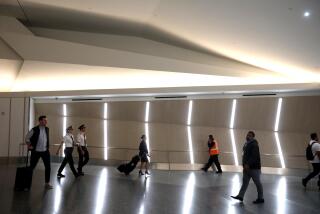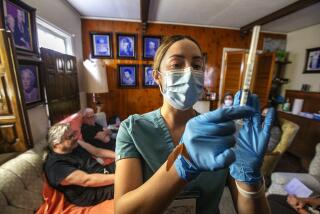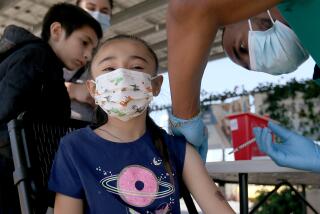COVID-19 vaccine inequities persist in L.A. County despite progress in underserved areas

- Share via
Los Angeles County has made significant strides in administering COVID-19 vaccines in communities of color hardest hit by the pandemic, but those areas continue to lag far behind both wealthier neighborhoods and the county as a whole, according to a Times data analysis.
Some neighborhoods in South Los Angeles — where the spread of the coronavirus was particularly devastating — saw the biggest increase in how many of their residents had received at least one vaccine dose between March 1 and Monday, the data show. Other areas that saw major improvement include Thai Town in Hollywood, Lennox and Cudahy.
However, despite the gains, these areas are still seeing vaccine rates below the county average.
In each of the 10 communities that has experienced the largest relative gains over the last six weeks, the share of the population age 16 and older that has received at least one vaccine dose remains under 30%. By comparison, 37.1% of L.A. County residents 16 and older had received at least one vaccine dose as of April 4, according to public health data.
The Times data analysis, which compared the growth in vaccination rates in communities with at least 5,000 residents, indicates that the county is making progress in its long-stated goal to ensure equitable distribution of the precious doses.
But, as L.A. County Public Health Director Barbara Ferrer noted this week, “We still have a long way to go.”
“A lot of work and thoughtfulness went into this. We’ve had a lot of support from our faith community. We’ve had a lot of support from community-based organizations,” she added. “We’ve had organizing efforts around this, making it easier for people to get to vaccination sites and giving us lists of places where we need to take the vaccines to people who have limited mobility. So that wasn’t by chance.”
Emphasizing this effort will become more important starting Thursday, when the county — and California as a whole — will begin allowing all residents age 16 and older to book appointments, a move that will add millions more people to the vaccination line.
Men are more likely to die from COVID-19, but less likely to get vaccinated. The gender gap troubles public health experts.
The Times analysis also revealed that while administration accelerated in some areas, others saw more modest increases. Notably, these areas tended to be wealthier communities that already had seen significant slices of their population inoculated.
From March 1 through Monday, the smallest relative increases in terms of the percentage of residents 16 and older who were at least partially vaccinated were seen in Westwood, Rancho Palos Verdes, Rolling Hills Estates, Palos Verdes Estates, Encino, Century City, Cheviot Hills, Beverly Crest, Beverly Hills and Bel-Air.
At least 50% of residents in almost all those communities, save Westwood, have received a vaccine dose so far.
Health officials have for months said the rollout of COVID-19 vaccines is being dogged by the same inequities in terms of healthcare access and poverty that have festered for generations.
For example, those who were able to take time off work to travel to a far-flung vaccine clinic, or could constantly refresh a web portal to snag an in-demand appointment, had a clear leg up over someone whose job was less flexible or who didn’t have the same access to transportation or the internet.
“People who can travel, who have cars, who don’t have jobs that make it hard for them to spend a lot of time on the computer looking for appointments, those were all people who were advantaged — particularly in the early days of the vaccine rollout,” Ferrer said.
Take Cheviot Hills, for example. Roughly 37% of the 16 and older population of the Westside community had already received at least one vaccine dose by March 1. That proportion has since grown to nearly 64%.
At the other end of the spectrum is University Park in South L.A., where only about 6.5% of residents had gotten at least one shot as of March 1.
That number has since grown markedly, to a bit more than 25%, but the community still lags well behind the county average in terms of vaccine coverage.
The median household income for the top 10 county communities with the biggest changes in vaccination rates over the examined time period is about $42,000. For those with the lowest, it’s $141,000.
Age was likely another factor in getting some communities off to a quicker start than others — as senior-age residents were among the earliest groups in L.A. County to be prioritized for vaccine access.
The top 10 communities with the largest recent changes in vaccine coverage rates skew much younger than the county as a whole.
The share of residents who are at least 65 in those places is 8.2%. For the places with the lowest relative vaccination rate growth, it’s 22.8%. About 14.1% of residents countywide are age 65 or older, according to the U.S. Census Bureau.
California and Los Angeles officials say they don’t expect the Johnson & Johnson stoppage will make it harder right away to get a COVID vaccine.
Issues of inequity are impossible to ignore, however.
Recently released data continue to show a stubborn gap in the countywide rate of vaccination among Black and Latino residents, compared with other groups.
As of April 4, 22.7% of Black and Latino county residents age 16 and older had received at least one vaccine dose, compared with 40.4% of Asian residents, 38.1% of American Indian/Alaska native residents and 37.1% of white residents.
This gap in vaccination coverage is especially worrying when it comes to the county’s Latino residents, who have been infected with and died from COVID-19 at higher rates than other groups.
Even with California on schedule to fully reopen in June, Whittier Boulevard business owners fear their customers will not return.
Officials and experts have long noted that lower-income Latino neighborhoods are highly susceptible to the spread of the coronavirus because of dense housing and crowded living conditions. A higher proportion of Latinos are also essential workers who have been unable to work from home or are employed in higher-risk settings — creating a circumstance in which they may have gotten sick on the job and then gone on to spread the virus to family members at home.
On top of an increased likelihood of exposure, Latinos also are less likely to have access to quality care due to long-entrenched structural inequities, “which is a recipe for not good things,” according to Dr. David Hayes-Bautista, a distinguished professor of medicine at the David Geffen School of Medicine at UCLA.
Unless these structural issues are addressed, “when the next pandemic hits, and it will hit ... we’ll see, unfortunately, the same tragic results,” he said in a recent interview.
Starting in early March, California began to devote 40% of its overall COVID-19 vaccine supply to communities that fall within the lowest quartile of a socioeconomic measurement tool called the California Healthy Places Index.
In the weeks since, L.A. County has made progress closing its vaccination gaps.
From March 4 to April 4, the proportion of L.A. County eligible-age Latinos who had received at least one vaccine dose more than doubled — from 10.5% to 22.7%, county data show.
Over that same period, vaccination coverage also rose substantially for American Indian/Alaska native residents, from 19% to 38.1%; and for Black residents, from 12% to 22.7%.
By comparison, Asian and white residents saw more modest, but still significant, increases in their countywide vaccination rates — from 22.6% to 40.4% and 21.2% to 37.1%, respectively.
“That’s a good sign indicating we’re closing the gaps, but we obviously need to do that more quickly,” Dr. Paul Simon, chief science officer for the L.A. County Department of Public Health, said during a recent briefing.
Simon said the county is continuing to take a number of steps aimed at improving vaccine coverage in harder-hit communities — such as distributing single-use codes that residents can use to schedule appointments near where they live, designating days at specific sites for residents in targeted areas, establishing pop-up and mobile vaccine clinics, and working with community groups to get the word out and to lower barriers to vaccine access.
“I do think as we continue to stay laser-focused on addressing the inequity in the vaccination rates and making sure that we’re just making it easier, we’re getting more information and doing a better job on the partnerships, we will close that gap,” Ferrer said.
More to Read
Sign up for Essential California
The most important California stories and recommendations in your inbox every morning.
You may occasionally receive promotional content from the Los Angeles Times.


















